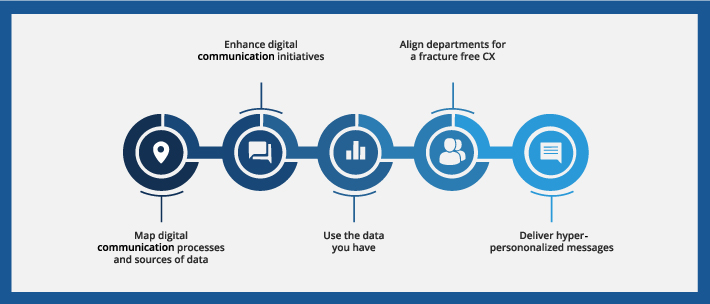Healthcare communications have shifted to digital
The accelerated shift of healthcare communications to digital platforms that we witnessed this year was driven by the need for virtual and contactless patient engagement, amidst the global pandemic.
I recently had the opportunity to chat with two of Doxim’s digital communication experts – Elizabeth Stephen and Mia Papanicolaou about the current state of healthcare communications.
We talked about how digital healthcare communications have become the standard, the benefits of this trend and best practices for adoption and success.

Tell us about some of the challenges associated with healthcare communications & how digital can help solve them?





A big challenge is the nature of healthcare communications. Everyone listening to this webinar is a patient and we’ve all received an explanation of benefits, which is like reading a document in another language. Trying to figure out what was covered, what’s owing and what all the extra charges are for – the nature of the communication itself can be very confusing.
Also, patients are interacting with other service providers on many different channels, but paper continues to be the only option available from healthcare providers. This becomes a disconnect, a fragmented experience overall, which causes a lag in meeting customer expectations and a lack of consistency across the channels.






Covid-19 accelerated the shift to digital in healthcare – why was healthcare lagging in terms of adoption pre-pandemic?





Healthcare was lagging other industries pre-pandemic, but the resulting shutdowns changed that trend as well as how we deal with healthcare and digital adoption.
There was a massive leap in digital adoption – for example, healthcare providers went from zero to 100% telehealth within a matter of weeks. COVID-19 has really boosted the healthcare industry in terms of digital transformation.
Liz: Part of the challenge in the healthcare industry has been due to concerns around regulations like HIPAA as well as the security of digital channels. This contributed to the lag in digital adoption before the pandemic.
The rise in the necessity of digital channels during the pandemic has resulted in sharp increases in the number of first-time users. McKinsey says that consumer adoption of digital channels vaulted 5 years ahead within 8 weeks. The pandemic also propelled the ‘silver tsunami,’ namely the older generations, who had to learn how to use digital channels to communicate with their families and to get critical services such as healthcare. The increase in new digital users is not going to reverse either, Instead, the numbers will continue to grow.
Because the healthcare industry was forced to leapfrog into digital services, healthcare providers need to get their patient communications up to speed as well. There is opportunity now to revise and revamp patient communication to meet the digital expectations of customers.






Patients are choosing digital healthcare communications. What are your thoughts about the security of digital vs traditional paper methods?





People are so used to physical mail delivery, but is it really secure? There are many privacy concerns relating to physical mail – theft, incorrect delivery due to human error and mail that is simply undeliverable.
We need to debunk the myth that physical mail is safe and secure . . . stories about theft and loss are pretty common.
According to The New York Times, the rate of package theft in the United States has been steadily increasing, with 90,000 packages disappearing daily in 2019 in New York City alone, up 20 percent from four years prior.
Across the country, more than 1.7 million packages are stolen or go missing daily, adding up to US$25 million in lost goods and services.
Digital delivery is far more secure than paper because it takes human intervention out of the equation, thus eliminating error and potential opportunity for theft. Digital delivery requires security all the way through the process – on the portal, as well as on the source systems. It’s far more secure than physical mail.





Anytime this point comes up with our customers, I ask them: how secure is your mailbox outside your house? Most people just chuckle.
The physical process is fraught with touchpoints that can be a security risk to PII. Whereas in the digital environment, there are many layers of security and authentication. While the delivery mechanism (portal or mobile app) is secured with username/password and 2-factor authentication, and these security protocols are constantly evolving to protect sensitive data.
Customers want digital. Don’t shy away from providing what patients want because of security concerns, rather balance customer experience with security and find the right solutions to deliver communications in a secure format.






Delivering patient communication in a timely manner, to the right mailbox, in the preferred channel, and securely, results in a better customer experience. How else will digital healthcare communications translate into a happier patient?





Providing the information as and when the patient needs it and, in the manner, they prefer, is the key. Few people would want to get a benefits statement or test result in the mail when they can get it immediately in a digital format.
Creating a happier patient means providing a platform that makes it faster and easier to consume important information.





More than 70% of patients today prefer digital communications; more than half expect digital capabilities. So, providing digital options cannot be a conversation of the future.
Yes, there are many obstacles to moving healthcare communication onto digital channels, but providers must figure this out to meet patient expectations.
A happy patient is a more engaged and receptive one. A happy patient is more likely to call their doctor (telehealth), get their documents self-serve from the safety of their home, put their credit card details into that payment portal – and drive down the revenue cycle time / time-to-pay.
When patients are considering whether to move providers, digital capabilities will be one of the criteria they use to assess their options. Meeting digital expectations becomes a retention imperative.






There’s no doubt that a great digital experience can make an incredible difference. Tell us about some of the best practices for moving patients and organizations toward digital maturity.





There are several ways to approach digital maturity. It is not an end goal; it must be seen as a journey. We’ve put together a digital maturity framework that we use to plot the starting point for healthcare providers and identify what needs to happen to move them along the digital maturity framework.
It’s about starting TODAY. Make micro-changes that make a difference to patients today, tomorrow and next week.
It’s not about a 5-year plan. Rather break up the projects into bite-sized chunks that will make a real difference to the patient. This is far easier in a digital environment.






What I would like everyone listening to this webinar to come away with, is: you must change, and you must be committed to making the change. And it must start now, with a 90-day plan.
What can you do in the first 90 days to affect change?
Cut down on operating costs by shifting customers to digital channels and at the same time, delight them by providing the channels they want and interacting with them in a more engaging environment.
Digital transformation has been a five-year topic for the industry . . . it seems like such a massive project when you consider you need to change all core legacy systems, all patient data systems and you need one single view of the patient – that’s going to take a long time.
Let’s rather look for micro-changes that you can make to affect an improved customer experience:
Start with what communications you are currently sending and what channels you offer. What can you change to improve adoption and reduce friction in the process? There are many little enhancements you can make using the data already on hand.
Getting started and committing to the path is the way to make forward progress.
My takeaway is that customer communication management (CCM) technology is designed to solve many of these challenges.
- It provides tools, resources and a platform to manage all communications across disparate systems and teams.
- It gives you nimble, self-service tools to rapidly deploy communications. It enables consistent messaging across all the different channels including print, email, SMS, and web.
- It really facilities a seamless transition between print and digital communication channels.
CCM technology allows you to stay ahead of the curve when it comes to patient communications and digital adoption.







